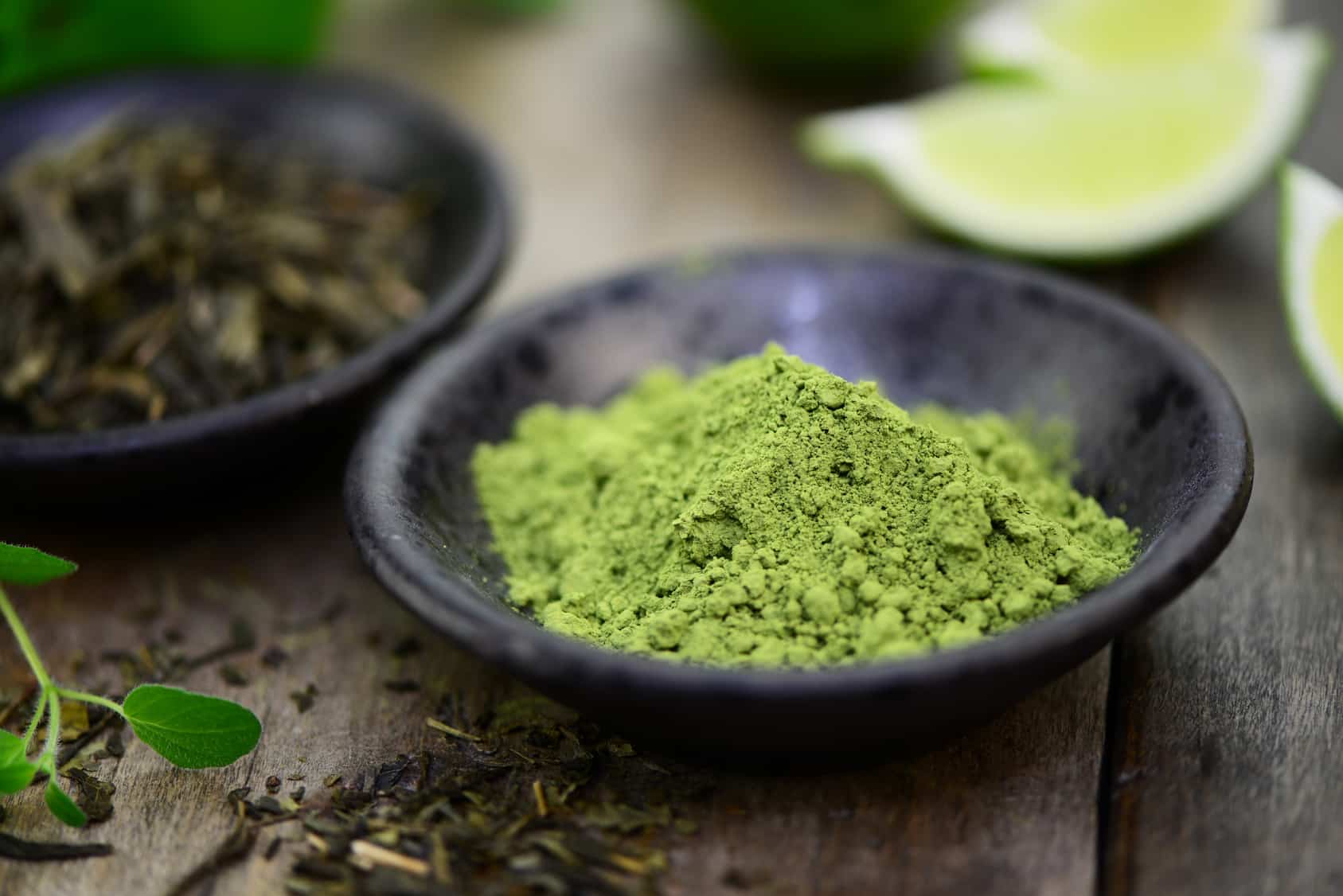Green Tea

Botany
The Camellia LINNÉ genus encompasses approximately 80 different species and belongs to the tea family (Theaceae). The coveted tea leaves are exclusively sourced from Camellia sinensis (L.) O. KUNTZE. Originally hailing from the mountainous regions of Southeast Asia, this ancient cultivated plant is no longer found in its natural habitat. Green tea, derived from the leaves of this evergreen and highly branched plant, exhibits considerable diversity in terms of both morphology and constituents due to cross-pollination. Precisely defining the various species is a challenging task, but in practice, distinguishing between green tea var. sinensis and green tea var. assamica has proven effective. Today, hybrids of these two species, which grow bushy and can reach heights of up to one meter, are primarily cultivated. Tea is harvested commercially in latitudes between 45° north and 30° south, with leading tea-producing countries including India, China, Sri Lanka, Turkey, Russia, Indonesia, and Japan.
Green tea itself is an evergreen, heavily branched shrub that naturally grows in a tree-like form. The leaves are leathery to the touch, have a dark green color, and are alternately arranged. For the production of medicinal tea, the young, downy-haired leaves of the tea bush (Theae folium) are used for their superior quality. These leaves are classified based on the following quality criteria:
- Imperial: Only the uppermost, not yet unfolded leaf, also known as peko tip.
- Fine: peko tip and two leaves (“two and a bud”).
- Coarse: peko tip and three leaves.
Harvesting takes place year-round in tropical regions and seasonally in temperate zones. While machine harvesting is possible today, the most selective harvesting is still done by hand.
The leaves obtained can be processed in different ways depending on their fermentation state:
- Fermented = Black tea (Theae nigrae folium).
- Non-fermented = green tea (Theae viridis folium).
- Semi-fermented = Oolong tea.
Green tea is produced by treating the fresh leaves with superheated steam for a few minutes in rotating cylindrical vessels or by inactivating the stubborn enzymes in shallow iron pans. This is followed by machine rolling of the leaves, reduction of the water content to 50% by drying, rolling again, and final drying in the sun.
Ingredients of Green Tea
Green tea comprises a diverse range of components that contribute to its health benefits and flavor. The primary constituents in tea leaves and the extract include polyphenols, purine alkaloids (methylxanthines), amino acids, polysaccharides, proteins, and lipids. In addition, smaller amounts of organic acids, volatiles, vitamins, and minerals are present.
Polyphenols make up the dominant group of major constituents, accounting for about 25 to 35% of the total. Within polyphenols, flavonoids, including catechins and flavonols, hold particular significance. Catechins, which represent the majority of polyphenols, constitute 17 to 30% of the total. Green tea contains various catechins in different proportions, including (±)-catechin (C), (-)-epicatechin (EC), (-)-epigallocatechin (EGC), (-)-epigallocatechin gallate (EGCG), and (-)-epicatechin gallate (ECG). Additionally, (-)-catechin gallate, (-)-gallocatechin, and (-)-gallocatechin gallate have been identified.
Catechin content varies depending on the leaf’s developmental stage, peaking at around 26% in the tip buds and decreasing along the leaf sequence. In the lower part of the shoot axis, catechin content averages only about 5%. This decrease results from the degradation of (-)-epigallocatechin gallate and (-)-epicatechin gallate, underscoring the importance of harvesting young leaves.
Green tea extract also contains free flavonols such as kaempferol, quercetin, and myricetin, with their di- and triglycosides present in higher concentrations of about 1.5 to 1.7%. Other constituents include free gallic acid and theogallin. Phenolic acids like caffeic acid, p-coumaric acid, ellagic acid, and the depsides p-coumaroylquinic acid and chlorogenic acid have also been detected in fresh tea leaves.
Caffeine, the primary purine alkaloid, is naturally found in tea. Its content varies little among black, oolong, and tea leaves, peaking in young top buds at over 4%. Theobromine and theophylline are also present.
Amino acids constitute about 4% of the extract, with theanine, a characteristic amino acid, being predominant. It is followed by aspartic acid, glutamic acid, arginine, and asparagine.
On average, the extract contains around 0.28% vitamin C (ascorbic acid). In contrast, black and oolong teas have lower vitamin C due to fermentation.
Other volatiles in the extract include linalool, d-cadinene, geraniol, benzyl alcohol, indole, and nerolidol. Linalool is the major volatile, significantly contributing to the aroma.
Effects and Applications of Tea Extract
The versatile properties of this extract are widely utilized in cosmetic and pharmaceutical formulations. Particularly, the antioxidant characteristics of polyphenols are highlighted, playing a significant role in cosmetics. The extract also exhibits antimicrobial and anti-irritant effects, contributing to its beneficial properties.
The antioxidant properties of catechins have been extensively studied and are primarily based on two mechanisms:
- Catechins form complexes with free divalent metal ions, essential for the formation of oxygen free radicals.
- Catechins serve as effective radical scavengers against oxygen, peroxy, and hydroxy radicals, which can cause DNA damage, harm other cellular molecules, and initiate lipid peroxidation.
The most active compound in the extract is epigallocatechin gallate, which exhibits antioxidant activities comparable to synthetic antioxidants like butylated hydroxytoluene (BHT) and butylated hydroxyanisole (BHA). These synthetic compounds are typically avoided in modern cosmetics.
Clinical studies have demonstrated that topically applied extract not only shields the skin from UV radiation-induced damage but also delays genetic cell changes and inhibits tumor formation. The skin’s protection is primarily attributed to the antioxidant properties of catechins.
The extract also exhibits deodorizing effects against compounds like methyl mercaptan, trimethylamine, and cigarette smoke. Both laboratory experiments (in vitro) and studies with living organisms (in vivo) have shown the odor-inhibiting properties of polyphenols. For instance, chewing candies containing 0.1% green tea extract after consuming garlic was observed to reduce bad breath.
The antibacterial properties of green tea extract against various bacteria and fungi find potential applications, particularly in aluminum-free deodorant products and foot care products. Additionally, extracts can be used in dental care products and mouthwashes due to their anticariogenic (caries-inhibiting) and deodorizing effects.
Applications of Tea (Camellia sinensis) and its Active Constituents in Cosmetics.; Molecules. 2019 Nov 24;24(23):4277.
Safety Assessment of Camellia sinensis-Derived Ingredients As Used in Cosmetics.; Int J Toxicol. 2019 Nov/Dec;38(3_suppl):48S-70S.
Antioxidant and Anti-Melanogenesis Effects of Colloidal Gold Camellia sinensis L. Extracts.; Molecules. 2022 Aug 30;27(17):5593
